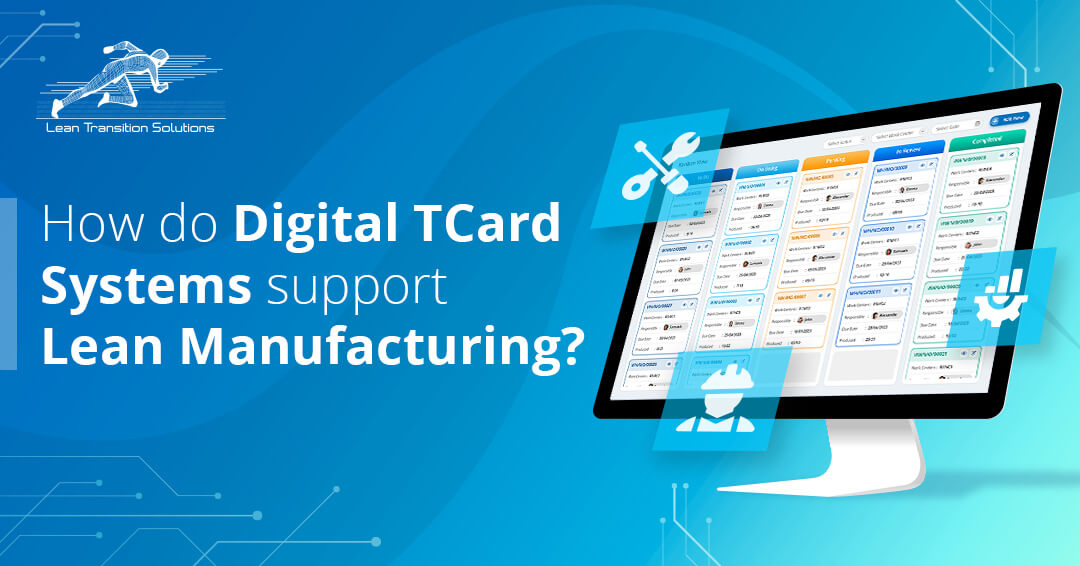How do Digital T-Card Systems support Lean manufacturing?
September 25, 2023
The manufacturing industry has undergone a remarkable transformation in recent years, and at the heart of this revolution lies the philosophy of lean manufacturing. Lean manufacturing is not merely a trend but a fundamental shift in the way in which businesses operate. Lean production is all about enhancing efficiency, eliminating waste, and optimising processes to gain higher levels of production efficiency. It's a journey towards perfection, where every facet of production is continuously analysed and improved upon.
Now, imagine having a tool that complements and amplifies lean manufacturing principles. The digital T-card software is designed to support and enhance lean manufacturing practices within organisations. Let's explore how the T-card system revolutionises the lean production processes and enhances efficiency, agility, and continuous improvement.
Lean Manufacturing System Explained
Lean manufacturing system is a comprehensive approach to production that seeks to eliminate waste, maximise efficiency, and deliver high-quality products or services to customers. One must explore its core principles and methodologies to grasp the concept of a lean manufacturing system truly. It involves minimising various forms of wastes, such as overproduction, excess inventory, defects, unnecessary waiting times, and underutilised employee skills.
Lean management is a mindset that values lean principles in all aspects of an organisation, from supply chain management to administrative processes. Lean operations radically transform the factory floor by fundamentally altering how production is organised, executed, and optimised. These transformations can be summarised as follows:
- Waste Reduction: During Lean manufacturing identifies and eliminates various forms of waste, including overproduction, excess inventory, defects, waiting times, and underutilised resources. Doing so streamlines operations and reduces operational costs.
- Just-in-Time (JIT) Production: Lean principles, such as JIT, encourage producing items only when they are needed, aligning production with customer demand. This minimises excess inventory, reduces storage costs, and efficiently allocates resources.
- Continuous Improvement (Kaizen): The relentless pursuit of continuous improvement is at the core of lean manufacturing. It fosters a culture of constant refinement, where employees at all levels identify and solve problems to enhance processes and increase productivity.
- Pull-based Systems: Lean management often employs pull systems, where production is triggered by actual customer demand rather than pushing products into the market. This approach minimises the risk of overproduction and associated waste.
- Visual Management: Visual tools like Kanban boards and Andon systems enhance communication and transparency on the factory floor, making it easier to monitor processes and respond to issues promptly.
- Flexibility and Adaptability: Lean manufacturing systems are inherently adaptable, allowing factories to respond quickly to changes in customer demand or market conditions and remain competitive in dynamic environments.
Tracing back the History of Physical T cards in Lean Manufacturing
Looking back to the history of physical T-card systems in lean operations reveals a rich heritage rooted in process efficiency through T-shaped cards to denote shop floor operational processes. Originating from the Toyota Production System (TPS) in the mid-20th century, T cards were physical cards used to represent tasks in production processes. Workers would move these cards along the t card board to signal task progress and manage the workflow.
The T card system facilitates transparency, allowing teams to identify bottlenecks and maintain optimal production flow. Over the years, the T-card system became a hallmark of lean manufacturing principles and a symbol of its commitment to waste reduction and continuous improvement. Although digital T-cards are replacing physical ones in modern manufacturing, the history of T-cards remains a testament to lean manufacturing practices.
What are Digital T-cards?
Digital T cards, or T card systems, are a modernised version of the traditional paper-based T card or Kanban system used in manufacturing and project management. These digital tools provide a more efficient and automated way to manage tasks, work orders, and workflows. Digital T-cards efficiently manage workflows and tasks in manufacturing and project management, aligning with lean principles and continuous improvement. They provide real-time visibility, reduce manual processes, and enable better collaboration among team members, ultimately improving operational efficiency.
How do Digital T-Card Systems support Lean Manufacturing?
Digital T-Card systems enhance lean manufacturing by improving visibility, automating processes, reducing waste, and enabling data-driven decision-making. They align with lean principles and support achieving maximum efficiency and continuous improvement in lean manufacturing processes.
- Real-time Visibility into Task Progress: Digital T-card systems provide real-time visibility into the status of tasks and work orders. Transparency in operational processes allows teams to quickly identify bottlenecks, delays, or issues in the production process, enabling them to take immediate corrective actions. The process aligns with lean principles of reducing waste and increasing efficiency.
- No more tedious Manual Labour: Unlike traditional paper-based T cards, digital T cards eliminate the need for manual card management, reducing paperwork and the risk of errors. Reduced manual work aligns with the lean principle of minimising non-value-added activities, enhancing efficiency.
- Streamlined Workflows: Digital T-cards streamline workflows by automating task assignments, updates, and notifications. Tasks move more smoothly through the production process, reducing lead times and improving Overall Operational Efficiency (OOE).
- Data-Driven Decision-Making: Digital T-card systems offer reporting and analytics capabilities. Teams can use data to analyse task performance, identify trends, and make data-driven decisions to optimise processes. Lean manufacturing emphasises data analysis as a key component of continuous improvement.
- Standardised Work: Lean manufacturing relies on standardised work processes to minimise variation and ensure consistency. Digital T card systems can include standardised work instructions and guidelines, helping teams adhere to standardised processes more effectively.
- Enhanced Inventory Management: Digital T-card systems can track materials and parts needed for production in real-time, ensuring that inventory levels are optimised and preventing overstocking or shortages.
- Remote Accessibility: Digital T card systems can be accessed remotely, allowing team members and managers to view and update task information from different locations. Remote access supports lean principles by enabling flexibility and responsiveness in production.
8 Easy Steps for Implementing Digital T cards in Lean Manufacturing Culture
- Conduct an Assessment and Plan accordingly: Analyse your existing workflow, identify bottlenecks, and assess how T-cards systems can improve the situation. Clearly state the goals and expected benefits of implementing a Digital T-Card system.
- Select the Right T-Card Software: Choose a Digital T-Card software or application that aligns with your needs. Look for features such as customisable card templates, real-time updates, and reporting capabilities.
- Migrate the Data and Set up the T-card board: If you are transitioning from physical T-cards to digital, migrate your existing data and cards into the new system. Set up the digital boards and card templates according to your workflow. Ensure they are easily accessible to relevant teams.
- Train your team: Train employees on how to use the Digital T-Card system effectively. Encourage teams to become familiar with the new digital workflow and emphasise its benefits.
- Customise T Card Templates: Choose digital T-Card templates that match your specific processes. Include relevant information, such as task descriptions, due dates, assigned personnel, and status.
- Get Real-time Updates and Notifications: Enable real-time updates so that changes in T-Card status are immediately reflected. Configure notifications and alerts to inform relevant parties of updates, deadlines, or issues.
- Integrate with Other Systems: Ensure the Digital T-Card system integrates seamlessly with other manufacturing systems, such as Enterprise Resource Planning (ERP) and Manufacturing Execution Systems (MES).
- Analyse data and Generate Reports: Utilise the data captured by the Digital T-Card system for analysis. Generate reports and dashboards to track performance, identify areas for improvement, and make data-driven decisions.
Digital T-Card Systems is a transformative tool that can significantly enhance lean manufacturing practices. Technological Integration with visual management tools like digital T-cards enhances organisational efficiency and communication. With real-time updates, customisable templates, and data-driven insights, Digital T-Card Systems support lean manufacturing by driving continuous improvement. Embracing this technology is not just a step forward; it's a leap towards lean excellence. So, make the digital shift today and unlock the full potential of lean manufacturing with the help of Tcard software.
